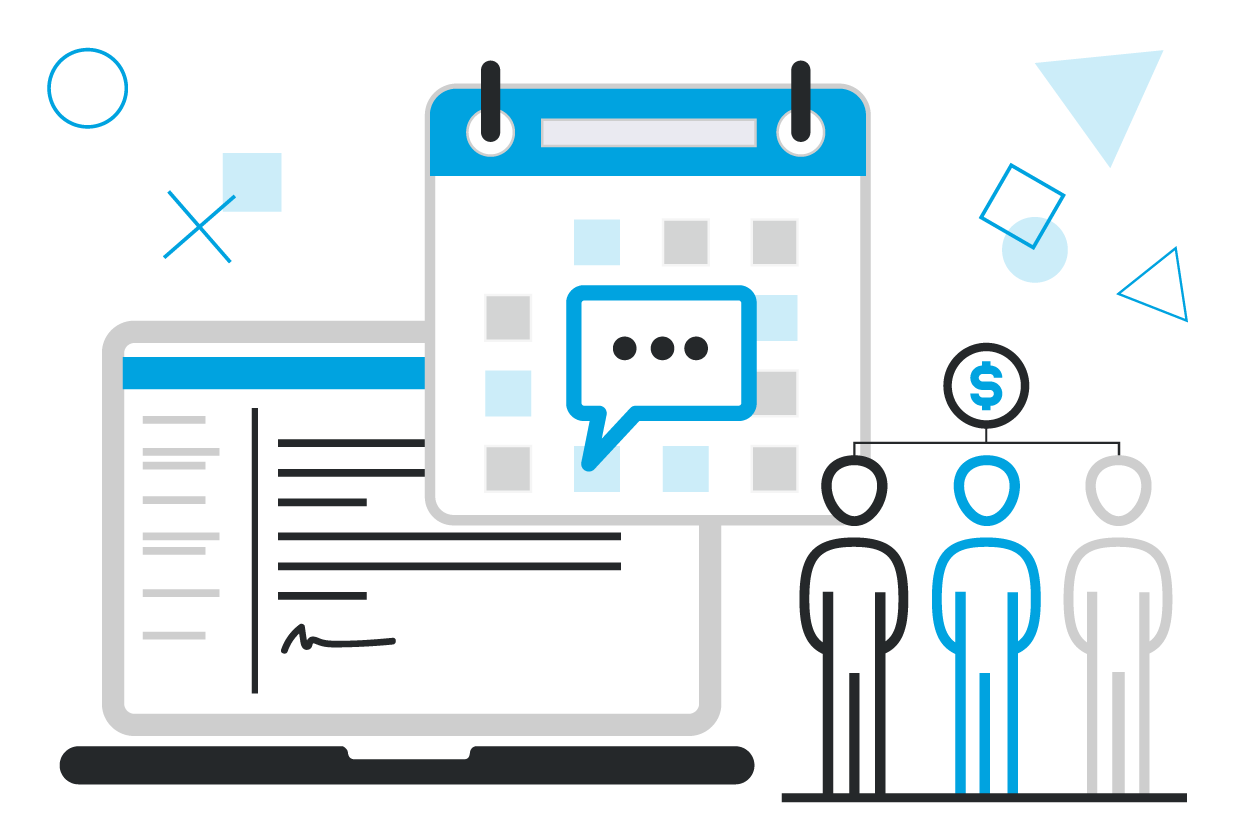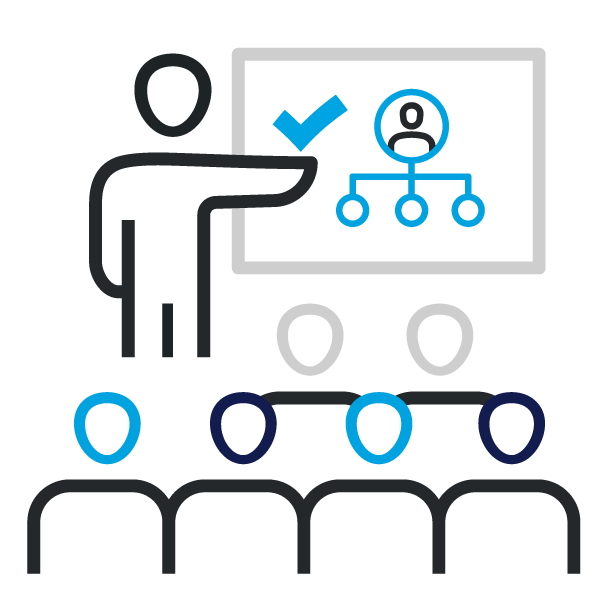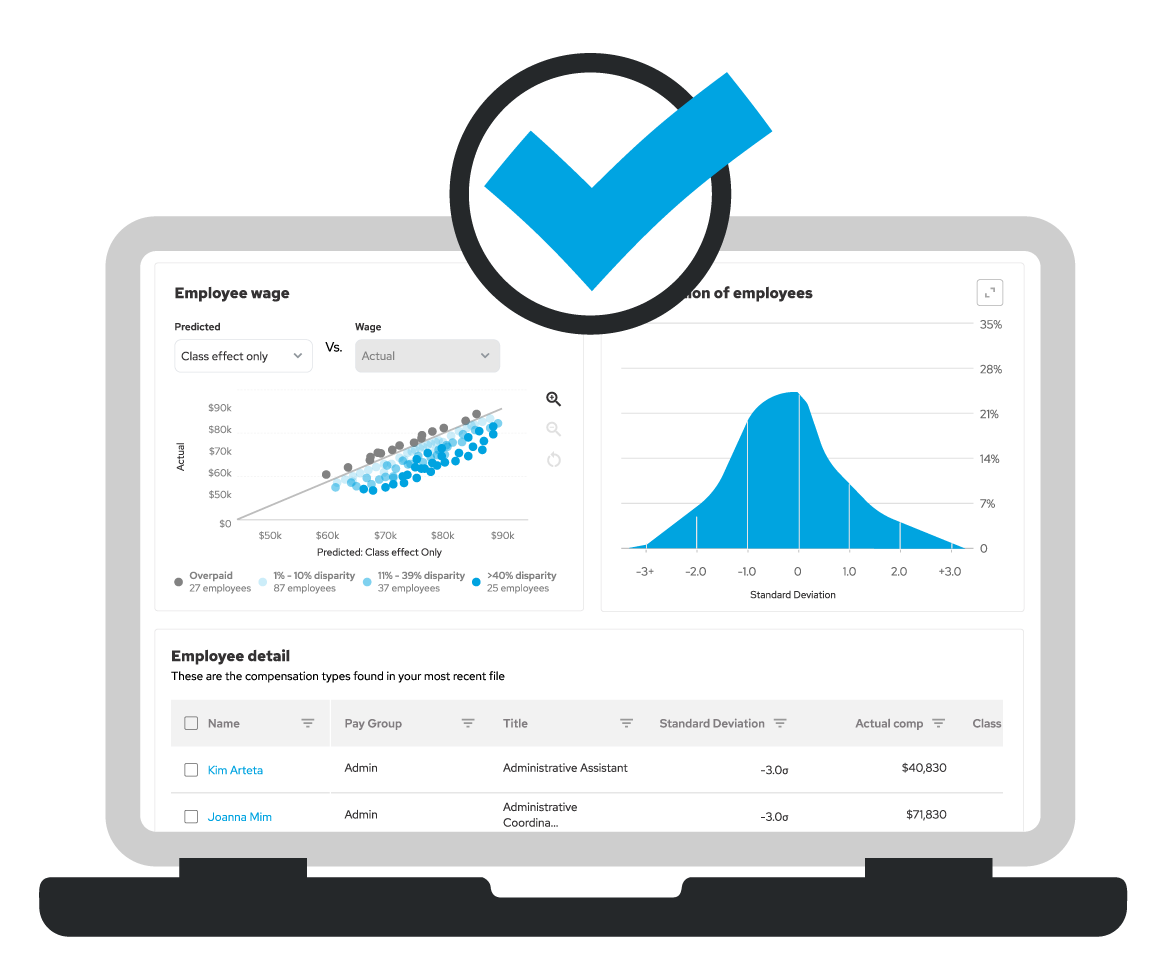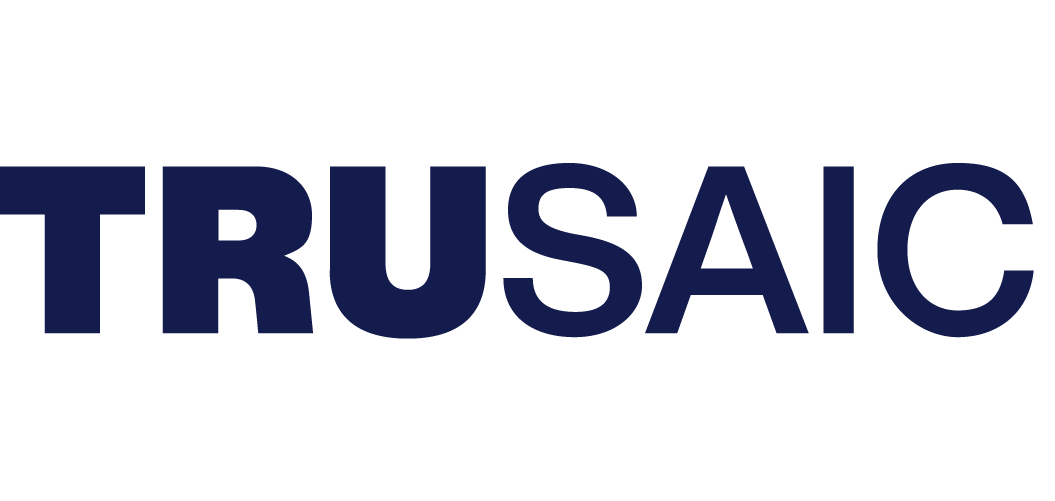The pay equity communications planner


Introduction
Employers are increasingly being asked to provide environmental, social, and governance (ESG) metrics to their stakeholders. A component of the social aspect that has taken center stage over the last several years is pay equity.
Pay equity is the concept of paying workers fairly, free of any type of discrimination. Incorporating pay equity into your workplace compensation structure is easier said than done. It requires top-down commitment, a culture deeply rooted in workplace equity and access, and like any other business function, it requires plan setup and strategy, with important metric monitoring and management. As the saying goes, "what gets measured, gets managed."
Let's say your organization is well underway with the above and you're on your way to making meaningful progress towards achieving pay equity in the workplace. What happens next is crucial to your goals and how the world will evaluate your efforts. Communicating pay equity to stakeholders is key and special attention should be given to your many different audiences.
We created The Pay Equity Communications Planner to help you share your pay equity progress in a thoughtful and actionable way.
Throughout this document we dive into the six steps you should take to develop your pay equity communications plan as well as highlight specific details pertinent to different audiences. But first, we wanted to talk about why you should think about your messaging.
Why communicating pay equity matters
The World Economic Forum predicts that it will take another 136 years to close the overall gender pay gap. Talking about pay equity internally and externally is key to solving the problem.
Employers that focus on their pay equity efforts, including communications, experience a number of positive benefits, including:
- Improved public, investor, and brand perception since pay equity is a major component of the social aspect of ESG.
- Increased business performance, due to most consumers wanting to purchase products and services from businesses that foster equal pay practices.
- Higher employee morale and engagement, since over 80% of workers are more productive and involved when they perceive themselves as paid fairly.
- Greater employee retention and new talent attraction because 75% of employees are more likely to apply for a job that promotes pay transparency.
In addition to the many benefits associated with pay equity, it's also the law of the land in many countries worldwide. To further drive social good, states, localities, and entire regions are introducing new legislation to make sure we finally close these longstanding gender and racial pay disparities.
But above all, prioritizing pay equity matters because it's the right thing to do. The Great Resignation of 2022 has highlighted the importance of treating employees fairly. Organizations that want to be successful in the future, should take stock in the idea of treating employees as they want to be treated.
When you focus on making your employees happy, they in turn will take care of your clients, and the cycle repeats. Pay equity is a fundamental component to creating a healthy, inclusive work culture. And planning on how you will communicate this important priority internally and to the world at large is critical.
Without further ado, it's time to get started with your pay equity communications plan.

STEP 1
Develop your plan for discussing pay equity
Documenting your plan for sharing details about pay equity is crucial for effectively communicating progress to various internal and external stakeholders. Your plan should be holistic and include everything from making the commitment to achieving pay equity as an organization to communicating salary changes to individual employees, and everything in between.
Start by segmenting your different audiences. Once you know who you will need to address, outline detailed instructions on how to talk about pay equity to each respective audience. Be sure to dive into discussing progress, what kinds of equitable pay processes you currently have in place, what steps you're taking to address pay disparities, and what employees can expect to see moving forward.
Depending on your audience, your discussions, key points, metrics, and overall tone will differ. It is also important to note that while an organization can promote pay transparency, that doesn't translate to the same specific details to the different audiences. For example, an organization may want to disclose to the individual employees the overall pay gaps and not the actual pay disparity after accounting for wage influencing factors for each job-specific category or as to a specific employee. we've included a sample template to help you organize your talking points for your different audiences.
Below we've provided examples of what to talk about with select groups of people and what it is they care most about regarding pay equity.
 Investors and shareholders
Investors and shareholders
This group cares most about the big picture and where your organization is headed. Your communication efforts to this audience should be strategic and include key performance indicators that demonstrate holistic progress.
Share the details of where your organization is headed with pay equity. Disclose the steps you've taken and what you anticipate to come in the future. If, for example, you've recently conducted a pay equity audit, your communications plan may want to include how the analysis was conducted and if you had any assistance from a third-party expert.
Details regarding your pay equity initiatives and any partners you are working with to achieve them can instill confidence in investors and shareholders. Show them you're taking pay equity seriously.
 Executives and the C-suite
Executives and the C-suite
C-suite leadership will be interested in learning about the impacts pay equity is having on your organization's bottom line, as well as investor and employee perception, and any legal risk. Your pay equity communications plan should provide instructions for disclosing this information to upper-lever roles within your organization.
In your communication efforts to this audience, highlight key data points to watch for throughout the pay equity journey, such as share price, ESG ratings, and compliance with any necessary legal requirements imposed by state or international regulators.
Executives at the top of your organization will also be interested to see how pay equity is improving your organization's culture and overall business performance. If you're experiencing higher employee morale, increased retention, and higher output as a result of your pay equity efforts, then include key performance indicators demonstrating such benefits in your communications. Be sure to emphasize that the greater success is coming from your various pay equity initiatives.
 HR and managers
HR and managers
The next subset to plan strategic communications to is your HR and managerial employees. In terms of messaging, the main difference between this group of employees and the C-suite is these individuals will focus primarily on communicating individual salary changes and less on big-picture metrics.
HR and managers will be responsible for discussing changes in pay to the rest of your workforce. Your pay equity communications plan for HR and Managers should therefore include step-by-step instructions for how pay equity is being determined in your organization. As such, it's most beneficial to educate them on the methodology used for identifying pay inequity and remediating it when found.
Pay equity methodology includes the wage influencing factors your organization takes into account when paying employees differently. It also includes how groupings are constructed for comparing employee compensation and how pay adjustments are determined. This will be crucial for communicating to employees directly impacted by any wage changes and equally as important for employees whose pay remains the same.
In short, individual contributors need to understand why their pay is changing and why it's not changing. Your HR team and managers will be responsible for delivering these important discussions.
The communications plan for this group should also include verbiage about receiving assistance from any third-party consultants. And your HR leads should be able to talk about the details of the partnership accurately.
In developing your communications plan for HR and managers, consider providing them with various resources to assist them in talking about compensation with the remainder of your workforce. Speaker prompts, FAQs, guides, and talking points could all be of immense value to this group.
 Individual workers
Individual workers
Unlike top-level leadership, individual workers will have a perspective on the organization's pay equity goals that impact them personally. The communications plan for this group should focus on key terms such as: pay equity, pay gap, pay disparity, remediation, pay analysis groups (PAGs), and bona fide factors. Use these terms strategically and clearly so that individual contributors understand how pay equity works.
It's critical to recognize that individual contributor conversations are not all the same. Some individual contributors will be receiving compensation adjustments with the timing and amounts potentially varying, and still, other employees will not receive any adjustments.
These various individual worker groups should understand the elements of a pay equity analysis and the importance of wage influencing factors as they apply to your organization to eliminate or minimize apparent pay gaps.
Employees should be encouraged to talk about pay if they are interested in doing so. Pay transparency can facilitate a positive, open work environment. In fact, including your employees in the conversation around pay is a way of increasing inclusion sentiment - a key driver to advancing workplace equity initiatives. Choosing to address discussions of pay in an inclusive and direct way will help your organization navigate compensation communications strategically in a way that is sensitive to every employee's concerns.
To learn more about the benefits of employee inclusion and pay transparency, read our research report, Creating a Culture of Diversity, Equity, and Inclusion, conducted by Harvard Business Review.
 Legal considerations
Legal considerations
Among the reasons for conducting a pay equity audit is to prevent or minimize the risk of pay discrimination lawsuits. Given this risk, conducting a pay equity audit under attorney guidance is key. An organization can conduct multiple audits for multiple purposes.
For example, a federal contractor may want to conduct a pay equity audit for OFCCP compliance purposes and a separate pay equity audit to assess litigation risk. While the former may not be protected from disclosure under the attorney-client privilege, the latter may be protected. Under that framework, such risk should be managed to recognize the competing risk of hiding your head in the sand.
Organizations today gather data about most metrics affecting their business so ignoring the pay equity data sends the message of indifference or, worse, indicates that the organization is allowing pay inequity to flourish. This message is loud and clear to the stakeholders. The riskiest strategy is to wait for a pay inequity lawsuit to address the issue when it is too late to be ahead of it in terms of messaging.
Managing risk can involve determining which metrics are communicated, how granular the details are of those metrics, and the timing of such communications.
With respect to pay disparities, the timing and the granularity of the details should be coordinated by counsel and may be appropriate after targeted remediation is achieved. If you announce to your employees the metrics showing that there are pay disparities, i.e., pay differences between women and men and/or among race/ethnicities that are not justified, you could be significantly exposing yourself to discrimination lawsuit risk.
Other resulting metrics that you may want to announce are diversity metrics, which are not as closely aligned with pay discrimination. This is how many organizations have chosen to address DEI metric transparency.
On the other hand, moving away from resulting metrics, if you announce to your employees the metrics associated with the process, such as your commitment, progress and achievement, the risk is managed. These communicated metrics are not about the resulting metrics such as the raw demographics and pay data for each employee or the resulting pay disparities. Rather, these communications should be about the commitment, progress, and achievement metrics.
Examples of progress and achievement metrics can include the pace at which women move up the corporate ladder as compared to men (and/or based on race/ethnicity), the changes in the salary differential between women and men in similar jobs (and/or based on race/ethnicity).
Examples of commitment, to corroborate a message of commitment, include expansion of the talent acquisition to focus on more racially diverse schools and the implementation of employee resources groups.
Examples of achievement in gender and intersectional pay equity could be an independent verification and certification by a third party, like the EDGE Certification. As many organizations still struggle with pay equity, this certification can be for the assessment, progress or achievement phase, each demonstrating to stakeholders your commitment in gender and intersectional equity, including pay equity.

STEP 2
Establish different communication mediums
You may be familiar with the expression, "it's not what you say, but how you say it" and the statement couldn't be any more appropriate in the context of pay equity. The delivery of sensitive information relating to pay is critical.
When creating your communications plan for talking about pay equity, consider the different communication channels you will use for delivering key messaging. Email, intranet messaging, social media, press releases, reports, etc., are all viable channels for communicating pay equity progress internally and externally.
However, given the sensitivity around pay, some communications will require more intimate, personal discussion. For example, you may not want to discuss a particular employee's changes in pay via email. This type of messaging calls for real-time communications, preferably one-on-one and in-person if possible.
On the other side of the spectrum, achieving your company's goal of eliminating any identified pay disparity within a particular department could very well be communicated in person during a company all-hands meeting. Discretion is needed when deciding which channels you'll use for which message.
To further help you understand the importance of key messaging through different channels, we've provided some examples on the following pages.
McDonald's
McDonald's Vice President of Global Business Services, Debbie Ballard, wrote a blog post that discusses the company values relating to pay equity. She discusses the progress the company has made, its current representation composition, and its long-term goals.
This outlet of communication provides all stakeholders with great visibility into McDonald's core pay equity goals, values, and current position on pay equity, diversity, and inclusion. While it doesn't dive into the specifics of employee pay adjustments, it's a great way of demonstrating to the public, investors, and employees that it's taken a serious position on pay equity.
You can read the blog post, as well as explore their other broader, pay equity and D&I messaging.
Apple
Publicly available right now is Apple's United Kingdom Gender Pay Gap Report for the 2020 tax year. The report includes specific data, metrics, and visualizations to illustrate the progress it's made towards achieving pay equity.
The report includes valuable insights into where the company was and where it's going. This information provides investors, shareholders, and government bodies with critical details for evaluating the company's commitment to pay equity.
Apple used the mandatory UK Gender Pay Gap Report as an opportunity to publicly showcase its commitment to advancing gender equality by making it available to the public. The UK Gender Pay Gap Report is tangible evidence that Apple is making meaningful pay equity progress.
General Motors
GM is one of the only companies to achieve worldwide pay equity and their website showcases it. Since 2001 GM has been making strides to achieve pay equity, increase representation and foster a culture of inclusion, and they have the data to back it up.
Similar to Apple's report, GM houses pay equity goals, commitment, and hard-evidence data on its website in its own section. There's an entire navigation system built-in as well. GM takes its pay equity commitment a step further by providing it within the greater context of ESG.
Disclosing your pay equity efforts allows all stakeholders to see you're committed to bettering the world through environmental and social governance. This is good for a number of reasons, most notably, it instils confidence that your brand is one concerned for the future of our planet and the well-being of humanity.
Choosing to share its pay equity and DEI information this way is also great for demonstrating progress to investors, governing bodies, shareholders, and the general public.
L'Oreal
Strategic organizations take their pay equity commitment and communications a step further by receiving certification. L'Oréal USA for example is EDGE certified following an independent, third-party verification. In a press release, L'Oréal outlines what the EDGE Certification means and how it confirms where a company stands in terms of gender and intersectional equity, including pay equity.
The press release states:
"EDGE Move and EDGEplus certification was granted to L'Oréal USA after an independent verification of the findings by third-party auditors. L'Oréal USA's certification accelerates its progress on a journey toward gender equity and gender balance, inclusive of multiple dimensions of diversity at all levels of the company. This work was first certified in 2014 when L'Oréal USA was one of the first companies worldwide - and the first company in the United States - to be EDGE certified."
Certifications are a great way of communicating on pay equity to all stakeholders. However, to be reliable and credible, such certifications need to be the result of rigorous verification processes carried out by independent certifiers.
Riot Games
Riot Games is an interesting example because several years ago the gaming giant found itself in a bad spot, due to a gender discrimination lawsuit brought forth by the California Department of Fair Employment and Housing (DFEH). The company has since taken immense action to resolve identified gender workforce inequities.
In December of 2021, the company reached a $100 million agreement with the DFEH. The example below outlines the end result of the case and showcases Riot's commitment to ensuring pay equity in the workplace.
In a crisis situation, the company responded appropriately and immediately took accountability for the accusations. While a reactive approach, Riot is making strides to transform its brand and company culture. Here's an excerpt from a statement the company recently made:
"Three years ago, Riot was at the heart of what became a reckoning in our industry. We had to face the fact that despite our best intentions, we hadn't always lived up to our values. As a company we stood at a crossroads; we could deny the shortcomings of our culture, or we could apologize, correct course, and build a better Riot. We chose the latter. We're incredibly grateful to every Rioter who has worked to create a culture where inclusivity is the norm, where we're deeply committed to fairness and equality, and where embracing diversity fuels creativity and innovation."
To be clear, Riot is not yet a leading example of how to approach pay equity, diversity, and inclusion within the workplace. The nature of their case called for a complete transformation of the company culture and workplace policies. Rather, they're an example of how to respond to an extreme crisis situation regarding pay equity and DEI. Riot demonstrates how organizations can right a wrong.
DISCLAIMER: The Pay Equity Communications Planner was created using internal expertise and publicly available pay equity information. Named organizations do not imply a relationship with Trusaic.

STEP 3
Schedule Communications
After you've established specific instructions for communicating pay equity to each audience, consider the importance of regularly scheduled messaging. Pay equity is important to a lot of people. To address each of your different audiences' needs, your overall plan should include regularly scheduled updates on progress.
While there is no set cadence for communicating pay equity progress, your approach should be systematic and consistent. You could, for instance, align your pay equity communications with annual reporting. Pay equity management, after all, should be treated just like any other business function and warrants thorough measurement and monitoring. What matters most is that your overall pay equity strategy includes routine progress announcements.
If you're taking a more aggressive approach to achieve pay equity, meaning you're trying to get there as quickly as possible, it would be best to announce communications on a more frequent basis. Work with the necessary stakeholders to develop a schedule that works for your organization.
Be sure to factor in room for unplanned messaging as well. If you've made breakthrough progress, hit a major milestone unexpectedly, or established a plan for accelerating your progress towards achieving pay equity, it should be celebrated and that may call for unplanned communications.
Bottom line? Compensation is an important topic for most people, so it's critical that you regularly provide status updates.
You want everyone to feel comfortable about the progress you're making, and actively communicating that will help.

STEP 4
Prepare for Crisis Communication Strategies
It's not something anyone wants, but crises do arise. If your organization finds itself in an unavoidable legal or otherwise public crisis related to pay equity, you're going to want to have a plan in place for minimizing lasting damages.
Your pay equity communication plan should include actionable steps for resolving crises that restore brand confidence and trust in all of your key stakeholders. Include a designated point of contact to address press and investor inquiries. It's also important to get ahead of the news as it circulates in these types of scenarios to control the narrative so make sure you're proactive in resolving the identified issue.
Above all - it's best, to be honest, and open. Recognize fault where it's due, don't pass the blame, and instead take responsibility. This owned accountability is critical for rectifying company mishaps, which brings us to the next step of your pay equity communications plan.

STEP 5
Take Ownership
Shared accountability is critical for many business functions and pay equity is no different. To ensure no one person is held responsible for pay equity, create a committee within your organization for holding department heads accountable for pay equity communications.
Your pay equity communications plan should clearly identify specific individuals, what they're responsible for, how they will be accountable (through, for example, incentives), and how they are actively communicating progress in and outside of your organization.
Beyond tasking specific individuals with communicating pay equity, taking ownership means making explicit efforts to achieve the initiative. Some organizations ensure success by tying organizational leaders' compensation, like the CEO's, to goals around pay equity.
This type of initiative ensures that pay equity gets prioritized and it demonstrates a commitment from the top-down. Additionally, it allows for everyone to get involved and promotes shared accountability across the entire organization.
Organizations that take ownership in this manner not only see greater progress in achieving pay equity, they're also further along in the pay equity maturity model.

STEP 6
Put Your Plan Into Action
Once you've documented your communications plan, it's time to put it into action. But if you don't currently have a system in place for establishing your pay equity goals and creating lasting change within your organization, then you need to take a step back.
We invite you to explore pay equity solutions that can help you develop your pay equity strategy for eliminating pay gaps, disparities and for communicating progress along the way.
Need help developing your pay equity communications plan and strategy? Let us help - we're here to help you achieve pay equity.
